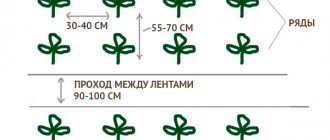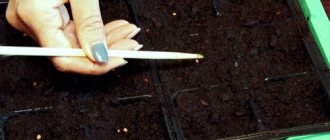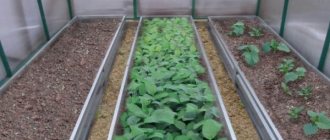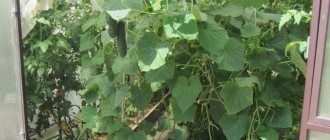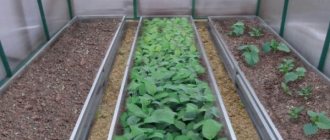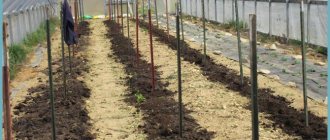Gardeners are concerned with the question of what they can use to plant eggplants to get a good harvest. Those plants that need the same amount of moisture, heat and light can coexist. It is advisable that vegetables receive the same fertilizers.
Eggplants are distinguished by good compatibility in the greenhouse with other crops. If a farmer does not know what to plant eggplants next to, this can provoke disagreements between crops, which will lead to reduced fruiting and death of the plant.
Some vegetables are naturally able to protect themselves from insects by releasing toxic substances that negatively affect other plants located near the crop.
The best neighborhood for eggplants
Farmers prefer to prepare for the season in advance. Already at the end of the winter period they soak the planting material. However, you can purchase seedlings at any time. Melons, beans or greens are good neighbors for eggplants in open ground. Tomatoes should be grown away from these vegetables.
What can be planted next to eggplants in open ground:
- bell pepper;
- zucchini;
- peas;
- cabbage;
- beets.
Where to plant eggplant next to
Onions and garlic should not be planted next to peas and beans, they are not friends.
For reference! The best option for what can be planted in greenhouses is bell pepper. This crop has fairly low bushes, which means they will not interfere with the growth of vegetables. They should be planted away from cucumbers.
Reviews from gardeners
Love, Moscow
I had 2 bushes left that didn’t fit into the greenhouse, so I planted them in the tunnel with the peppers. The tops were good, but there were no eggplants. So it also depends on the place.
Source: forum.tvoysad.ru
Olga, Odessa
I plant mine in the flower garden, the distance to the potatoes is huge. The beetles begin to crawl onto the eggplants only after they eat the neighbor's potato plantation.
Source: chudo-ogorod.ru
Bad neighborhood for eggplants
Agrotechnicians often wonder what crops are not suitable for growing together with eggplants and what they can be planted with in the same bed. Ideally, choose a plot in your garden where only eggplants will grow.
How to plant eggplants
Tomatoes are bad neighbors for them, so these crops cannot be grown next to each other. They are exposed to the same pests. Example: the tomatoes were attacked by spider mites, which means the eggplants will soon be infected. If the disease affects the foliage of the plant, then the neighboring crop will also begin to wither and die.
Among plant diseases, powdery mildew can be distinguished; it spreads quickly. You should also consider in detail the issue of watering the soil. Eggplants love moisture. Therefore, they require regular and abundant watering, while tomatoes, on the contrary, can easily tolerate drought. If you water a common garden bed abundantly, the tomato bush may become bogged down in water, the fruits will begin to rot, and you may not get a harvest at all.
For reference! Eggplants love the shade, and tomatoes love the sun.
Thus, the answer to the question of what you can plant eggplants next to is definitely not tomatoes. Potato bushes can also be considered an unfavorable neighborhood, as they are susceptible to attacks by Colorado potato beetles. If these harmful insects jump onto the eggplant bushes, there will be no harvest.
Tomatoes are bad neighbors for eggplants
Conditions suitable for growing
Eggplants are one of the capricious garden crops. So that all the efforts put into growing them are not in vain, it is advisable to provide them with certain conditions:
- The plant should not experience a lack of sunlight.
- Watering must be done at the root. It is unacceptable for water to get on leaves, flowers and fruits. Warm water should be used for irrigation.
- The crop needs regular fertilizing.
- The air should be dry and not cold.
Important ! Excessive application of organic fertilizers is not approved, because they activate the growth of green mass, which in turn negatively affects productivity.
Now it's time to talk about which neighbors will not become pests for the little blue ones.
Eggplant goes well with pepper
What crops can be planted next to eggplants in a greenhouse?
Before planting, you need to clarify which crops they get along with and which they do not. Do not forget that eggplants are a demanding vegetable; they need to receive a lot of light every day and be protected from the wind. But at the same time there must be high soil moisture. Plants that will grow in the neighborhood should not be tall so as not to shade the bushes.
bell pepper
How to plant eggplants in open ground with seeds
Peppers are considered the best neighbors for eggplant. Both crops have the same requirements regarding air humidity and light. The pests of peppers and eggplants are also identical, so it will be easier to deal with them. Both plants are approximately the same in height, so they will not interfere with each other.
Important! Only one type of pepper can be planted in one greenhouse: either sweet or bitter. Otherwise, you can provoke cross-pollination.
The seedlings are prepared as follows:
- Seeds are selected and disinfected.
- Seedlings are grown at home, on the windowsill.
- The site is prepared and the greenhouse is installed.
- Seedlings are planted in open ground.
- The seedlings are sprayed with Bordeaux mixture.
Bell peppers and eggplants in one bed
Eggplants and peppers are planted no earlier than 2 weeks after frost. The most important thing is that the earth warms up to the desired temperature.
cucumbers
Cucumbers are considered a heat-loving crop. Both cucumbers and eggplants have the same care requirements. This simplifies the farmer’s task because he does not have to separately select preparations for treatment or calculate the amount of watering. Despite the fact that the crops are different, they bear fruit at the same time. But it is necessary to monitor the air humidity so as not to harm the eggplants. After all, after watering, cucumbers release moisture, so the blue ones can begin to fall off and rot.
Corn
Corn is a tall plant, but despite this, it does not in any way prevent the eggplant bushes from receiving light. Plus, it protects the vegetable from the wind. Although drafts rarely enter the greenhouse, this is more common when growing vegetable crops in open ground.
What they don’t imprison with
Eggplants do not get along with all crops
The culture feels uncomfortable next to tomatoes. The reason is that the parasites and diseases of these plants are the same. Tomatoes do well in dry climates. Another reason for a bad neighborhood is daylight hours: for tomatoes it is much longer.
Potatoes are not planted nearby because of a common parasite - the Colorado potato beetle. This pest parasitizes the crop, destroying the plant.
Bad neighborhood
Then plant eggplants
Experienced gardeners know that eggplants do not grow well next to nightshade crops. This is due to the condition of the soil layer. In a short period of time the land will be dried out. Numerous feedings will help correct the situation a little.
And if there are eggplants and tomatoes next to each other, problems may arise in terms of watering. The former require regular and abundant watering. That is, the farmer is at a crossroads: either the eggplants will dry out or the tomatoes will rot.
Fertilizing of vegetable crops
Having chosen the right neighbor, you need to decide on feeding. Since the plants have similar care requirements, one fertilizer is suitable for two people. The composition of the classic feeding includes:
- 500 ml of ash;
- 40 ml potassium sulfate;
- 40 ml superphosphate;
- 20 ml urea.
Feeding eggplants
If the area for growing vegetables is sandy, then it is better to add compost, peat, clay soil with sawdust in advance. On average, 2 buckets are needed per greenhouse.
Greenhouse cohabitation: rules of care
Vegetables living in the same greenhouse require especially careful care. The top layer of soil is replaced annually; before planting, the soil is spilled with a solution of copper sulfate or potassium permanganate. The soil is fertilized with humus, wood ash and a small dose of mineral fertilizer (superphosphate, potassium sulfate) are added to it.
If seedlings are grown in a greenhouse, it is better to allocate a separate area for them
When transplanting seedlings to a permanent place of residence, it is important to make sure that they are completely healthy
If pest larvae or signs of disease are detected, the seedlings must be cured and only then moved to the greenhouse.
Early maturing hybrids are more suitable for co-location. They are productive and disease resistant. For prevention, young plantings are treated with a weak solution of potassium permanganate, and during planting growth they are sprayed with phytosporin or other non-toxic biological preparations.
Plants planted in one greenhouse can feel very good and not reduce productivity
It is important to closely monitor their condition in order to take timely measures in case of problems. Next year, you can make adjustments to the plantings taking into account the experience gained.
Useful information in the video below:
Joint planting
Before planting seedlings in the soil, you need to harden off the greenhouse in advance.
- In the room, the thermometer should show +17-18 degrees.
- During the first week, the temperature regime is lowered during the day, a few days before planting, and at night.
- Over time, watering is done less frequently.
- Seedlings can be taken out onto the balcony.
- A week before planting, the seeds are treated with a solution of Bordeaux mixture. To do this, dilute 50 grams of the drug in 10 liters of warm water. Such procedures will protect the plant from various fungal infections. During the same period, fertilizing with mineral fertilizers is carried out.
- A couple of days before transplanting the planting material, the seedlings are watered abundantly.
Important! You can transplant seedlings into a greenhouse if the height of the seedlings has reached 20 cm. Both eggplants and peppers are planted at the same time at the end of May.
The beds should also be prepared. Clay and loamy soils are added to the soil. For each square meter, 2 buckets of peat, 1 bucket of fine river sand, manure and compost, half a bucket of sawdust.
Applying fertilizer to the soil
Fertilizer is applied to any soil, no matter what type it is. The soil is prepared by adding the following composition:
- 500 ml of ash;
- 40 ml potassium sulfate;
- 40 ml superphosphate;
- 20 ml urea.
After applying the fertilizer, the soil should be dug up, the surface should be leveled and lightly compacted. Then holes are made up to 15 cm deep. The composition (500 ml of mullein and 10 liters of water) is poured into each hole. One liter of solution is used per well.
Watering vegetable crops is carried out as follows:
- Before flowering, 2 liters per bush once a week.
- From the moment of flowering and during fruit set - 2 times a week, 3 liters for each bush.
Important! After the soil dries out, the soil around the plant must be loosened, not going deeper than 5 cm.
Many farmers, when planting a particular plant, are guided by the phase of favorable days according to the lunar calendar. It helps you choose good days to plant.
In the middle zone, it is better to grow eggplants in greenhouse conditions to protect the plant from wind and cold. If the structure is constructed correctly, not a single pest will get inside.
3.7 3 votes
Article rating
Zoning
If it is not possible to install 2–3 greenhouses on the site, then you can make them from one. Divide the territory into the most optimal zones for each type. If you plan to grow two crops, you can make an additional entrance and make a partition from polycarbonate, oilcloth or polyethylene.
This will help you grow, for example, tomatoes and eggplants in the same room. Airing tomatoes will not harm their “neighbors,” and frequent watering of eggplants will not create excess moisture for the tomatoes.
If it is impossible to make a second entrance, simply separate the bed with eggplants from the lowest to the highest point of the greenhouse with film, creating a microclimate suitable for them . You will get a kind of wall in the “room”, which you need to enter only when necessary.
And a few more tips:
- When growing several crops in a greenhouse, plant each one on a separate ridge;
- eggplants grow well on the south side ; cucumbers can be planted between them and peppers;
- make beds in the greenhouse up to 1 m wide, paths up to 70 cm, this is the best option for caring for plants and making optimal use of the available space.

